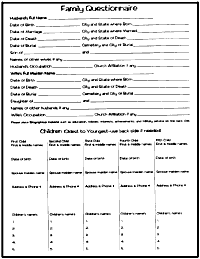|
ORGANIZING AVAILABLE DATA 
Don't waste your time searching for details you may already have but you do not have it readily available. From memory write down your immediate family onto one of the blank family group sheets found on pages 2-15 and 2-16 in The Complete Beginner's Guide to Genealogy, the Internet, and Your Genealogy Computer Program (abbreviated as CBG). A family group includes parents, children, and the spouse of each of those children. Record their dates and places of birth, marriage, and death. As you can locate the proper details use the guidelines on pages 2-3 to 2-6 to enter them in the proper format. The appropriate form used to record a family unit is called a family group record. Click here to see various kinds of family group records. Now fill out another family group record using two more blank forms in your textbook (pages 2-17 and 2-18) to fill it out for your father's parents. Then fill out another family group record using pages 2-19 and 2-20 for your mother's parents. Continue on to your great grandparents if possible. Using Pedigree Charts for an Overview of Your Family Once you have your family information recorded on family group
records, you can step back and take an overall look at your ancestors
using pedigree charts. Please refer to pages 2-1 to 2-3 in your CBG textbook to learn more about using pedigree charts in your research. Click here to see various kinds of pedigree charts. Pedigree Charts are often referred to as Ancestral Charts. And Family Group Records go by a variety of other names as well because different software developers want their reports to be unique. Some examples were shown by clicking the links above. But all of them allow for arrangement of our families so that the important information is included. One thing researchers learned early is that computer programs are programmed to provide just so much space in each field so that reports can be designed. Because of this, names you enter by pencil now, may need to be adjusted to fit an area in a template. The "Your Turn" Assignments on page 2-2 of your textbook, the bottom one on page 2-3, and page 2-6 number 1 a, b, & c will help you understand this concept. It is wise to do those assignments on your own. For example, do the self-evaluation on page 2-31. Check the "Your Turn" answers you gave on pages 2-2 and 2-6 with the answer key on page 2-31. Take time to learn how to scan documents (another skill needed by a genealogist) and to learn how to attach a scanned image. Practice by uploading a scanned image of your pedigree chart to a friend to see how it appears. Each e-mail service attaches scanned files differently, so use your help features on your e-mail program to learn now to attach files. If you don't have your own scanner, contact a local library, family history center, or your local college. You will have assignments in the future that will require a knowledge of sending electronic files to your instructor. Once you have filled in your personal family information in pencil onto family group records and a pedigree chart, it will be readily available to data enter into a genealogy computer software program. |
|
|
